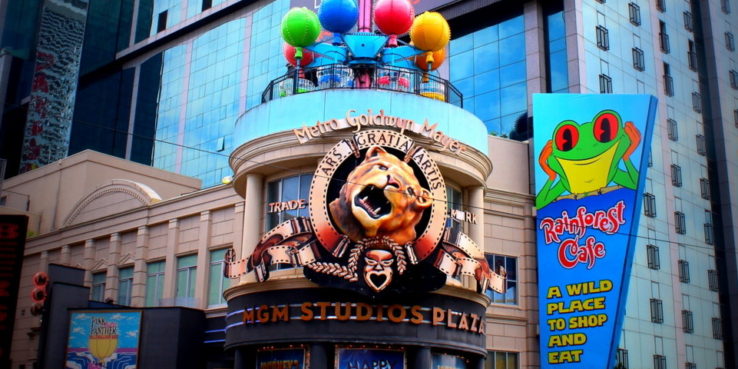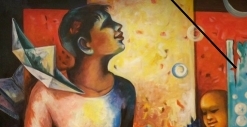The main street of the city of Niagara Falls, the one on the Canadian side of the famous falls, may seem as a scaled-down version of Las Vegas. A sparkling hub of neon signs, flashing lights, 3D, 4D and even 6D (!) entertainment complexes, diners and franchise restaurants that offer combo meals with supersizing options. Basically, everything that American entertainment industry is good at, condensed into one street. Affordable and accessible, no-nonsense, mass entertainment, packaged and sold to anyone who needs to lose his troubles away for a couple of hours.
The Rainforest Cafe, a chain restaurant themed after a rain-forest, is a perfect example of this. As you step into its dimly lit setting, you are met with dense, jungle vegetation on its ceiling and walls, voices of birds and the occasional roar of mechanical elephants that move their ears and gorillas that drum on their chests. The waiters are dressed as safari guides in khaki shirts and short pants. And the menu is full of dishes with exotic names. A great fun for kids, and those unburdened with refined tastes.
It’s easy to be snobbish about it. Having just recently traveled to Berlin and Switzerland, the town feels like the epitome of what America has historically been known for in Europe: the marriage of large, loud and tasteless. As someone who prefers Ingmar Bergman and Umberto Eco to Michael Bay and Stephen King, my first impulse was to write the whole thing off as a proof of the inferiority of American mass entertainment to European culture. After all, a typical European restaurant boasts a dining experience that is based on centuries-long tradition, natural ingredients and an emphasis on a selection of wines, rather than quickly served fries and soft drinks in plastic cups. And unlike an IMAX movie that relies on quick gratification, an opera is an intricate art form that builds up emotion and drama slowly.
Does that mean that American mass entertainment is essentially “fake”, while European tradition is “true” and “authentic”? That was certainly my first feeling. But the more I thought about it, the less obvious the answer was.
The American consumerist lie is so obvious that no one falls for it. No one is deluded into thinking that Wendy’s is something more than a cheap hamburger, or that IMAX movies have more to them than an eye-catching, loud spectacle. Since the target audience is so broad, the illusion can’t be more than only thinly concealed. When the restaurant’s decor is from plastic, the waiters’ uniform ridiculous, and the dishes have silly, made-up names, the truth seeps through the seams. And what can be more revealing than a slogan like “a wild place to shop and eat”. All of this makes you starkly aware you aren’t a jungle explorer, but a customer that gets a good value for his money. But you may play the game nevertheless, because it’s fun.
But a French restaurant will have you believe you are getting more than just a nice meal – that you are partaking in something that is wholesome and pure. An evening in the opera house will make you believe that you are not just entertained, but also spiritually enriched. All of it deadly serious and “for real”. But isn’t that just a more elaborate lie, one that goes to far greater lengths to conceal the artificiality of it? Isn’t a fine, eight-course meal’s claim to be more than just a good food in a way more fake than a humble hamburger? Could it be that an opera house’s claim to be a keeper of essential renaissance tradition, rather than just a sophisticated entertainment is a bigger lie than cinema owner’s billboards announcing the newest summer blockbusters?
Lights and neon signs were lighting up when we were leaving the city in the evening. And in the back seat of a speeding car, I was finding its embracing invitation slightly more charming.



Nicely written. Though the fundamental difference between the European experience and the American one has to do with more than a mere difference in style IMHO. It isn’t even about “true” and “fake”, it’s ideological and political. American hyperrealism tries to “save the reality principle”, to use Baudrillard’s words, by creating layers of reality. Simulacra created in order to sharpen the difference between what SHOULD be perceived as real and what can be easily treated as a nonthreatening simulation, the new opium for the masses and so on..
Thank you Or for bringing up Baudrillard’s work, which I wasn’t familiar with. Reading on his concepts of hyperreality, simulation and simulacrum made me realize the crucial difference between American and European experience, which I tried to capture in this post but couldn’t quite articulate.
European experience usually tries to simulate something real, something that actually existed. Today’s opera simulates the original reinesaunse tradition; a regional cousin restaurant tries to capture the spirit of what dining used to be a century or two ago.
American experience on the other hand creates hyperreality – something that is so “over the top” that it makes the regular reality look washed and faded. A hyperreality , that doesn’t refer to anything that actually existed but masks an emptiness.
A classical example of this is Disneyland, whose magical realism is so elaborate that after a while you start regarding reality as boring ; the city of Las Vegas that didn’t grow from any real city but was created from ground zero to suck up your mind and your wallet; the Rainforest cafe whose made up world of course doesn’t reference any real forest, and whose appeal is intended to lie in the magical realm, rather than trying to be an authentic simulation.
There is something nauseating and disgusting in this fantasy world, a feeling somewhat similar to being on a roller-coaster, trying to reach a ground that isn’t there. But there is also something authentic in this fantasy, since it doesn’t try to fake anything real, unlike the European simulation.
But now you have to explain me what do you mean by “saving the reality principle” and “layers of reality”.
Michael, while reading, I got a feeling you have never been to Paris or Vegas, have you?
I haven’t. Your point being?
Well I find it strange to compare something I don’t know… unless you are a fantasy or fiction writer
In the post I was comparing Niagara Falls to Berlin and Switzerland, actually.
And what is wrong with my mention of Las Vegas? Did you discover a different city from what we all know? Please share your insights.
Well, your description of Niagara Falls ( and my personal impression ) resembles a paradise for kids, which is very different from Vegas ( definitely not the picture of NF you describe, and definitely not for kids ). The only thing that may have some resemblance is the themed casinos vs themed restaurants/arcades, but its very different.
Regarding Paris, my bad you didn’t mention it, it must have been my own association to “high class/culture” Europe, which in my humble and subjective perspective is shit.
I don’t really understand what you try to compare or criticize in this article? You on your own choose this cheap restaurant ( with theme for kids ) and you wonder why is it so shitty.
For me American way is the freedom of choice and the plenty: you want cheap crappy food ( I used Wendi’s a lot and not ashamed of it ) – you got it, you want fancy restaurant ( like in Europe ) – you can have it too ( or Opera if you will, been in those too, not in Opera of course ).
So what is your point? Find a better restaurant next time ( you could enter one of the fancy casinos in NF and get a high class high priced meal ).